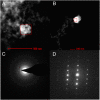Biomass combustion produces ice-active minerals in biomass-burning aerosol and bottom ash
- PMID: 32839314
- PMCID: PMC7486733
- DOI: 10.1073/pnas.1922128117
Biomass combustion produces ice-active minerals in biomass-burning aerosol and bottom ash
Abstract
Ice nucleation and the resulting cloud glaciation are significant atmospheric processes that affect the evolution of clouds and their properties including radiative forcing and precipitation, yet the sources and properties of atmospheric ice nucleants are poorly constrained. Heterogeneous ice nucleation caused by ice-nucleating particles (INPs) enables cloud glaciation at temperatures above the homogeneous freezing regime that starts near -35 °C. Biomass burning is a significant global source of atmospheric particles and a highly variable and poorly understood source of INPs. The nature of these INPs and how they relate to the fuel composition and its combustion are critical gaps in our understanding of the effects of biomass burning on the environment and climate. Here we show that the combustion process transforms inorganic elements naturally present in the biomass (not soil or dust) to form potentially ice-active minerals in both the bottom ash and emitted aerosol particles. These particles possess ice-nucleation activities high enough to be relevant to mixed-phase clouds and are active over a wide temperature range, nucleating ice at up to -13 °C. Certain inorganic elements can thus serve as indicators to predict the production of ice nucleants from the fuel. Combustion-derived minerals are an important but understudied source of INPs in natural biomass-burning aerosol emissions in addition to lofted primary soil and dust particles. These discoveries and insights should advance the realistic incorporation of biomass-burning INPs into atmospheric cloud and climate models. These mineral components produced in biomass-burning aerosol should also be studied in relation to other atmospheric chemistry processes, such as facilitating multiphase chemical reactions and nutrient availability.
Keywords: aerosol–cloud–climate interactions; atmospheric chemistry; climate change; heterogeneous ice nucleation; wildfires.
Conflict of interest statement
The authors declare no competing interest.
Figures




References
-
- Mülmenstädt J., Sourdeval O., Delanoë J., Quaas J., Frequency of occurrence of rain from liquid-, mixed-, and ice-phase clouds derived from A-Train satellite retrievals. Geophys. Res. Lett. 42, 6502–6509 (2015).
-
- Fan J. et al. ., Review of aerosol–cloud interactions: Mechanisms, significance, and challenges. J. Atmos. Sci. 73, 4221–4252 (2016).
-
- Storelvmo T., Aerosol effects on climate via mixed-phase and ice clouds. Annu. Rev. Earth Planet. Sci. 45, 199–222 (2017).
Publication types
MeSH terms
Substances
LinkOut - more resources
Full Text Sources
Medical
Research Materials
Miscellaneous

